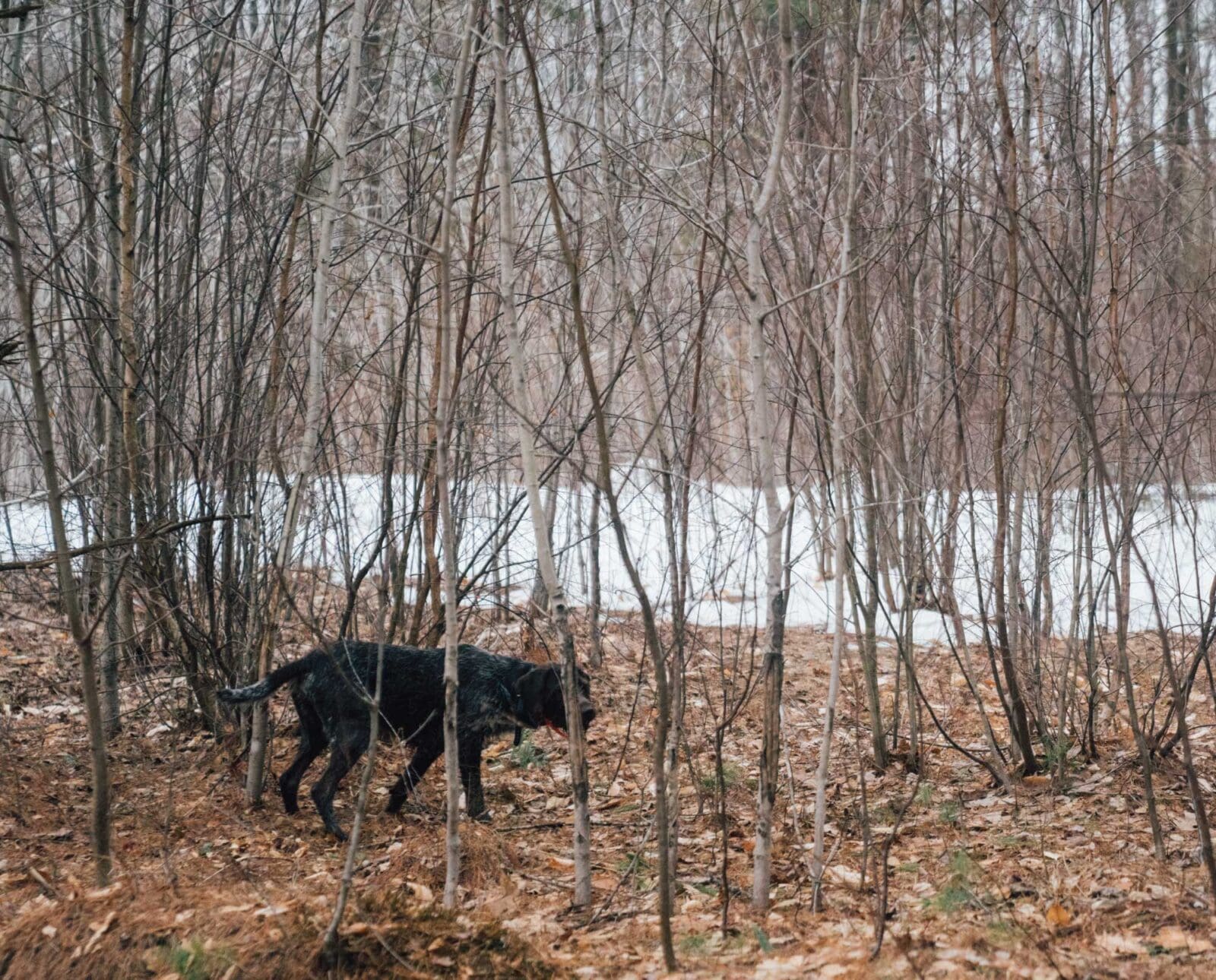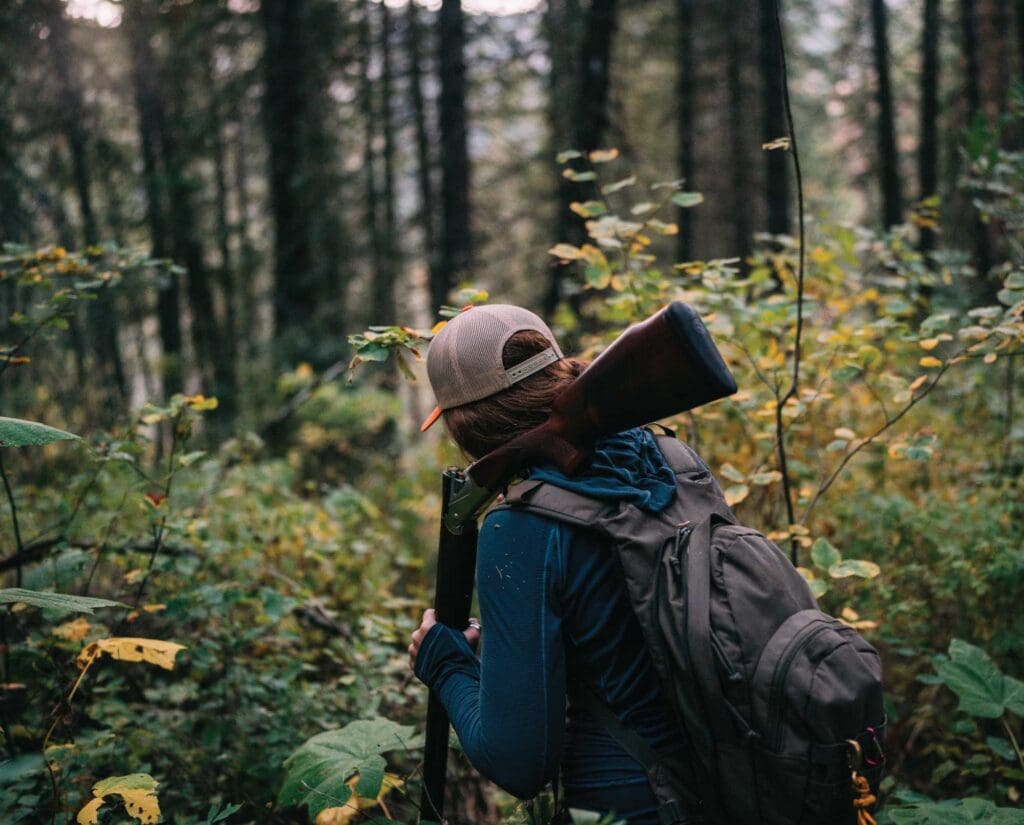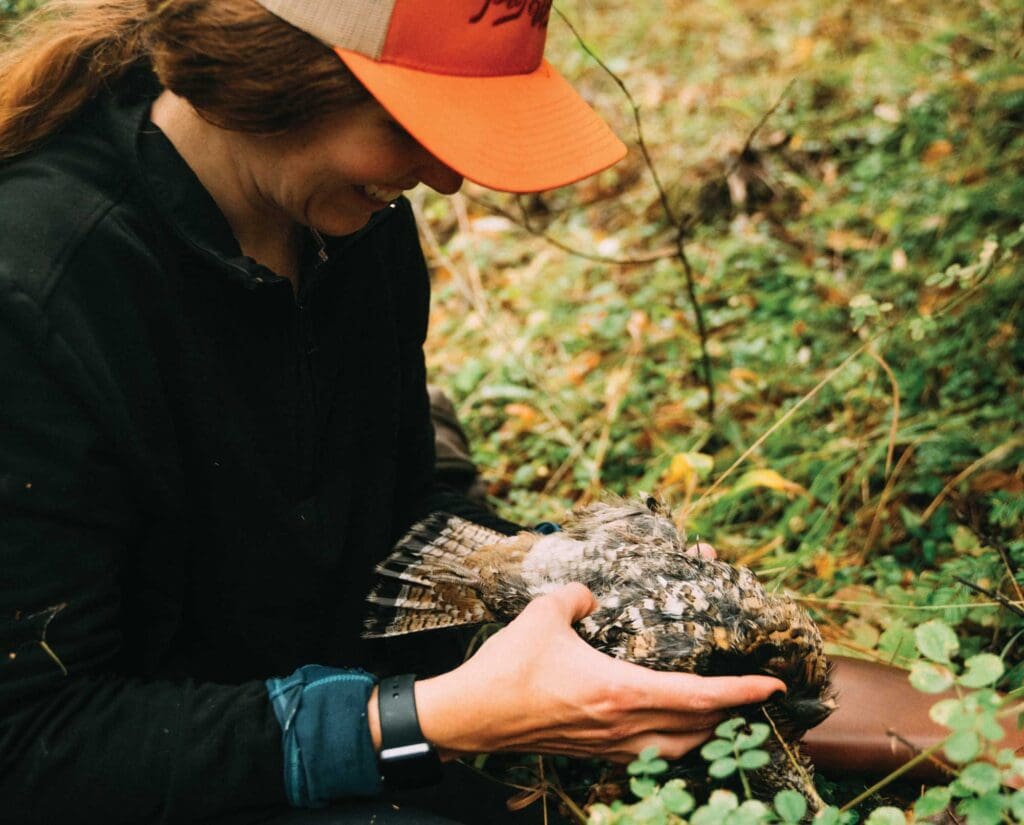Home » Hunting Dogs » A Beginner’s Guide to Approaching a Bird Dog on Point
A Beginner’s Guide to Approaching a Bird Dog on Point

I am a very new, first generation, adult-onset, female uplander…
Knowing how to walk up to a dog on point can increase your chances of success in the uplands
As the sun started to crest the adjacent ridge on the opening day of grouse season, our pack of three hunters and two dogs was already well into our hunt. Hilltop, as we had come to call this spot, was a sure place to find ruffies. It wasn’t long before we were right in the thick of them. Being a novice with a new French Brittany pup, Hayward, by my side, knowing we were hunting in a good spot excited me. When Hayward went on point, it was apparent he was staring right at a ruffed grouse in a spruce tree not ten feet in front of me. I went racing to the dog, gun at the ready.
Listen to more articles on Apple | Google | Spotify | Audible
My husband, Tanner, is a far more experienced hunter than I am. He went up the hill and around the backside of the tree instead of walking straight to Hayward. It was too late when I realized I was in the wrong place. As I desperately tried to get out of the way, the grouse burst from the tree and flew exactly where Tanner had expected it would. No shot was fired for fear of hitting me.
Although this was a great learning experience, I couldn’t have been more frustrated in the moment. I lost my first grouse because of a silly mistake: being in the wrong place. Since then, I have closely watched my mentors and asked many questions. As the season progressed and we began hunting chukar and Hungarian partridges, I started to put the puzzle together; it’s much easier to see what is happening in the sage than in the thickly wooded forest.
Most importantly, I learned not to walk straight at the dog. During one of our mentor-to-mentee chats, I was reminded that the dog can put pressure in only one direction. Walking to the dog at an angle, instead of coming in directly behind, puts even more pressure on the bird to hold or flush in a shootable direction. Knowing how to angle your approach to a dog on point efficiently leads to higher chances of putting birds in your bag.
Several factors play pivotal roles in successful flushes off of a point. These factors rely on the dog, the surrounding environment, and the bird. As you approach the dog, pay attention to its body language, the wind and moisture conditions, the surrounding cover, and how you apply pressure to the bird.
Understanding Your Dog’s Body Language When They’re On Point
Understanding your dog’s body language is crucial. Appraising the direction and quality of the wind and assessing the moisture in the air and on the ground are clues to triangulate where bird smells might be coming from. Identifying surrounding cover and how that particular bird species retreats away from pressure aids in pinpointing a potential flushing location. When you can understand these practical elements of approaching a dog on point, you can position yourself more strategically.
Learning what your dog is telling you is part of what makes hunting with a dog so magical. A pointing dog’s body language communicates a ton while standing stock still. Different breeds and individual dogs will have their own style of communication. It is also dependent on the age of the pup and its training.
Here’s a quick caveat for those awesome NAVHDA and staunch point trainers out there. My pups and the dogs I hunt with have almost entirely been trained on wild birds. They do a fantastic job but probably wouldn’t win any awards. My goal in this article is to make some generalizations that encourage newbies to watch the dog and have an idea of what they might be looking for. That being said, dogs use the same five senses we do. Dogs are far more in tune with their prey, especially regarding their sense of smell and hearing abilities.
A dog’s whole body communicates simultaneously. The speed and intensity of a pup pointing can give a reasonably good clue to the proximity of a bird. When a dog gets a whiff and keeps moving with intention, pausing from time to time, obviously searching, they tell you there is a hint of a bird somewhere in the vicinity. Compare that to a bird dog slamming on point so fervently they nearly fall over. When that happens, it becomes crystal clear they are informing you, “The bird is RIGHT HERE!” Also, when they are released and hardly move, that’s another sign that your quarry is likely holding just in front of you.
Similarly, the position of their body hints at the same idea. When a dog is pointing tall with their head in the wind, it means there is a scent nearby. Whereas, when that same four-legged’s chest is nearly touching the ground, and their head is lowered like a prowling wolf, there is likely a bird just ahead.
Although a bird dog’s nose is pointed a certain way, it does not necessarily indicate the bird’s direction. A pointing dog stiffens when their senses tell them a bird is close, no matter which way they face.
When you get to know the dog you hunt with, its eyes and ears become just as communicative as anything else. These subtle movements help hone in on bird positions. For example, my pups will be locked solid on point but roll their eyes to look at me. They say, “They’re close, but I don’t know exactly where.” Contrarily, when their eyes are laser-focused, unwavering, they say, “Right here!” Sometimes, this even means, “I can see the bird!”
Likewise, when their ears twitch or turn slightly, it probably means there are running birds or the dog is in the middle of a covey. Either way, they can hear birds moving around them.
An interesting and helpful side note is that pointing dogs often look very different when it is not a bird they are smelling. Their heads are really high, and they have an almost surprised expression about them. This has come in handy several times when encountering skunks, porcupines, and even bears. When this happens, it reminds me to always listen to the bird dog; they just know better.

Understanding wind and moisture conditions when approaching a dog on point
Appraising the wind and moisture is pro-level bird dog stuff. Having a constant idea of wind direction allows you to triangulate where exactly that scent your pup is pointing might be coming from. Understanding moisture levels on the ground and in the air tells you how readily the dog’s sniffer can pick up bird smells.
Let’s start with wind, rather, what to do when there’s no wind at all. Complete stillness keeps the bird’s scent strongly pooled, which can make for great hunting conditions. When the dog sniffs it out, they have an exact idea of where the bird is. The only hitch is they have to get closer to find it.
Contrast that with mild wind, which is my favorite, and you have the makings of an unforgettable day. Think of a warm pie cooling on a window sill. That sweetness permeates the whole house and makes the neighbors jealous. Under these conditions, birds smell just like that to dogs. A gentle breeze will pick up that pooled scent and waft it right to their searching noses. Your dog will float towards that smell like Bugs Bunny does when he gets a whiff of carrot stew in a Looney Toons episode.
Things get trickier as the wind speed picks up. When it is gusty outside, the bird scent gets carried on the wind, but then it dies down and becomes confusing for the pup. You’ll notice bursts of intensity followed by uncertainty in the dog’s body language. If the wind is howling like crazy, good luck. Any pooled scent gets blown away, and the gale drowns out even small whiffs. Either that or the dog has no idea how far away the flash of scent is coming from. Hunting in windstorms is tough stuff for both you and your dogs.
Frequently, the wind is accompanied by moisture, but not always. They play off of each other and can change everything for the dog. The moisture and scent relationship for the dogs is equal to pouring hot water over coffee grounds. When there is no water, the grounds’ aroma is lackluster and hardly reaches beyond the bag it’s in. However, add water, and the whole place is pungent with that tantalizing roasted coffee bean smell.
For dogs, running on a dewy morning is just like making coffee. They can even track where a bird has been by the lingering scent of their footprints. After a rainstorm, bird scent is more concentrated, which leads to less tracking because everything has been washed clean. For the dog, all that is left to fill their nostrils is the hot scent of upland birds. A light drizzle acts roughly the same way as just after a rainstorm, while medium to heavy rain seems to knock down the scent and get the birds hiding in cover that’s harder to penetrate.
Returning to the coffee analogy, the temperature of the birds plays a considerable role. When it has just snowed, not only does their scent pool but so does their heat. Dogs pick up on that. For this reason, hunting is much easier when it is snowing than when it is raining. Additionally, upland birds just don’t seem to mind the snow hardly at all. In fact, they use the cover to their advantage.

Identifying Potential Bird Cover On Your Approach
Identifying cover can prepare you for where a bird might pop up or fly to. A quick survey of the surroundings can inform the way you approach the dog and set up for a clean shot. Be aware of the kind of cover the species you are chasing likes to hang out in. Grouse hang out in thick brambles or trees. Pheasants love tall grass clumps, typically on the edge of more water-rich cover. Chukar and huns seemingly pop up out of nowhere—quail like all kinds of cover, especially Russian thistle and sage in my neck of the woods.
The gist is to identify where they might be hiding and where they will likely head for safety when they flush. It’s a split-second thing to do, but it can mean the difference between hitting a bird and missing one.
“Walk into a point in such a way that the dog can see, but it doesn’t feel pressed or rushed by you,” my hunting mentor, Thomas, says to me all the time. “Then, evaluate which direction the flushing bird is likely to go, usually to cover, and walk into the point in the direction that allows the best shooting opportunity.” Having an educated guess as to where the bird is headed is the best way to be prepared when it flushes.
Apply Pressure Appropriately Depending on the Bird Species
Knowing the bird beyond what cover they prefer gives you an idea of how it might act when the dog’s point puts pressure on them. Some birds will hold as long as the dog does. Others will cut and run. In my experience hunting wild birds, grouse and quail hold fairly tightly, especially with multiple dogs on the ground. Pheasants, huns, and chukar are different stories. They will run out from under the dog’s nose fast, especially if you’re hunting in a highly trafficked area.
No matter how prepared you and your dog might be, there will always be times when the bird flushes wildly in an unexpected direction. It might be a pheasant bursting up between your legs, a grouse sneaking out the other side of a tree, or a covey of quail popping up right behind you. However, once you start to recognize patterns and get better at interpreting your dog’s body language, you’ll find yourself in the right place to get a bird in the bag more and more often.
The feeling of knowing your dog and knowing the bird is rewarding beyond measure. It makes you think you might be a real uplander after all.
I am a very new, first generation, adult-onset, female uplander from Eastern Oregon, where I live with my husband, Tanner, and our two dogs, Lenny and Hayward. The untainted meat and exercise is what got me into it, but the love of bird dogs gets me out most weekdays and nearly every weekend during the season. I am passionate about sharing my experience as a novice bird hunter in order to encourage others, from all walks of life, to try it out.





Great article. You are so spot on about understanding and learning how to read a dog’s body language.